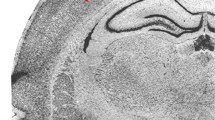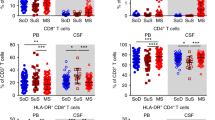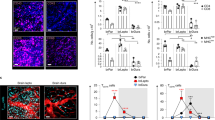Abstract
Lymphocytic choriomeningitis virus1 infection of the mouse central nervous system (CNS) elicits fatal immunopathology through blood–brain barrier breakdown2 and convulsive seizures3. Although lymphocytic-choriomeningitis-virus-specific cytotoxic T lymphocytes (CTLs) are essential for disease4, their mechanism of action is not known. To gain insights into disease pathogenesis, we observed the dynamics of immune cells in the meninges by two-photon microscopy. Here we report visualization of motile CTLs and massive secondary recruitment of pathogenic monocytes and neutrophils that were required for vascular leakage and acute lethality. CTLs expressed multiple chemoattractants capable of recruiting myelomonocytic cells. We conclude that a CD8+ T-cell-dependent disorder can proceed in the absence of direct T-cell effector mechanisms and rely instead on CTL-recruited myelomonocytic cells.
This is a preview of subscription content, access via your institution
Access options
Subscribe to this journal
Receive 51 print issues and online access
$199.00 per year
only $3.90 per issue
Buy this article
- Purchase on Springer Link
- Instant access to full article PDF
Prices may be subject to local taxes which are calculated during checkout




Similar content being viewed by others
References
Kang, S. S. & McGavern, D. B. Lymphocytic choriomeningitis infection of the central nervous system. Front. Biosci. 13, 4529–4543 (2008)
Marker, O., Nielsen, M. H. & Diemer, N. H. The permeability of the blood–brain barrier in mice suffering from fatal lymphocytic choriomeningitis virus infection. Acta Neuropathol. 63, 229–239 (1984)
Camenga, D. L., Walker, D. H. & Murphy, F. A. Anticonvulsant prolongation of survival in adult murine lymphocytic choriomeningitis. I. Drug treatment and virologic studies. J. Neuropathol. Exp. Neurol. 36, 9–20 (1977)
Fung-Leung, W. P., Kundig, T. M., Zinkernagel, R. M. & Mak, T. W. Immune response against lymphocytic choriomeningitis virus infection in mice without CD8 expression. J. Exp. Med. 174, 1425–1429 (1991)
Bajenoff, M. et al. Stromal cell networks regulate lymphocyte entry, migration, and territoriality in lymph nodes. Immunity 25, 989–1001 (2006)
Bromley, S. K., Peterson, D. A., Gunn, M. D. & Dustin, M. L. Cutting edge: hierarchy of chemokine receptor and TCR signals regulating T cell migration and proliferation. J. Immunol. 165, 15–19 (2000)
Storm, P., Bartholdy, C., Sorensen, M. R., Christensen, J. P. & Thomsen, A. R. Perforin-deficient CD8+ T cells mediate fatal lymphocytic choriomeningitis despite impaired cytokine production. J. Virol. 80, 1222–1230 (2006)
Johnson, E. D., Monjan, A. A. & Morse, H. C. Lack of B-cell participation in acute lymphocyte choriomeningitis disease of the central nervous system. Cell. Immunol. 36, 143–150 (1978)
Leist, T. P., Cobbold, S. P., Waldmann, H., Aguet, M. & Zinkernagel, R. M. Functional analysis of T lymphocyte subsets in antiviral host defense. J. Immunol. 138, 2278–2281 (1987)
Tepper, R. I., Coffman, R. L. & Leder, P. An eosinophil-dependent mechanism for the antitumor effect of interleukin-4. Science 257, 548–551 (1992)
Kurihara, T., Warr, G., Loy, J. & Bravo, R. Defects in macrophage recruitment and host defense in mice lacking the CCR2 chemokine receptor. J. Exp. Med. 186, 1757–1762 (1997)
Marchi, N. et al. Seizure-promoting effect of blood–brain barrier disruption. Epilepsia 48, 732–742 (2007)
Asensio, V. C. & Campbell, I. L. Chemokine gene expression in the brains of mice with lymphocytic choriomeningitis. J. Virol. 71, 7832–7840 (1997)
Kaech, S. M., Hemby, S., Kersh, E. & Ahmed, R. Molecular and functional profiling of memory CD8 T cell differentiation. Cell 111, 837–851 (2002)
Wherry, E. J. et al. Molecular signature of CD8+ T cell exhaustion during chronic viral infection. Immunity 27, 670–684 (2007)
Andersen, I. H., Marker, O. & Thomsen, A. R. Breakdown of blood–brain barrier function in the murine lymphocytic choriomeningitis virus infection mediated by virus-specific CD8+ T cells. J. Neuroimmunol. 31, 155–163 (1991)
Doherty, P. C., Allan, J. E., Lynch, F. & Ceredig, R. Dissection of an inflammatory process induced by CD8+ T cells. Immunol. Today 11, 55–59 (1990)
Walker, D. H., Camenga, D. L., Whitfield, S. & Murphy, F. A. Anticonvulsant prolongation of survival in adult murine lymphocytic choriomeningitis. II. Ultrastructural observations of pathogenetic events. J. Neuropathol. Exp. Neurol. 36, 21–40 (1977)
Wedmore, C. V. & Williams, T. J. Control of vascular permeability by polymorphonuclear leukocytes in inflammation. Nature 289, 646–650 (1981)
Bjork, J. & Arfors, K. E. Oxygen free radicals and leukotriene B4 induced increase in vascular leakage is mediated by polymorphonuclear leukocytes. Agents Actions Suppl. 1163–72 (1982)
Rosengren, S., Ley, K. & Arfors, K. E. Dextran sulfate prevents LTB4-induced permeability increase, but not neutrophil emigration, in the hamster cheek pouch. Microvasc. Res. 38, 243–254 (1989)
Hixenbaugh, E. A. et al. Stimulated neutrophils induce myosin light chain phosphorylation and isometric tension in endothelial cells. Am. J. Physiol. 273, H981–H988 (1997)
Sekido, N. et al. Prevention of lung reperfusion injury in rabbits by a monoclonal antibody against interleukin-8. Nature 365, 654–657 (1993)
Herwald, H. et al. M protein, a classical bacterial virulence determinant, forms complexes with fibrinogen that induce vascular leakage. Cell 116, 367–379 (2004)
Tacke, F. et al. Monocyte subsets differentially employ CCR2, CCR5, and CX3CR1 to accumulate within atherosclerotic plaques. J. Clin. Invest. 117, 185–194 (2007)
Maus, U. et al. The role of CC chemokine receptor 2 in alveolar monocyte and neutrophil immigration in intact mice. Am. J. Respir. Crit. Care Med. 166, 268–273 (2002)
Ancuta, P., Moses, A. & Gabuzda, D. Transendothelial migration of CD16+monocytes in response to fractalkine under constitutive and inflammatory conditions. Immunobiology 209, 11–20 (2004)
Stamatovic, S. M. et al. Monocyte chemoattractant protein-1 regulation of blood–brain barrier permeability. J. Cereb. Blood Flow Metab. 25, 593–606 (2005)
Intlekofer, A. M. et al. Anomalous type 17 response to viral infection by CD8+ T cells lacking T-bet and eomesodermin. Science 321, 408–411 (2008)
Beal, A. M. et al. Protein kinase Ctheta regulates stability of the peripheral adhesion ring junction and contributes to the sensitivity of target cell lysis by CTL. J. Immunol. 181, 4815–4824 (2008)
McGavern, D. B., Christen, U. & Oldstone, M. B. Molecular anatomy of antigen-specific CD8+ T cell engagement and synapse formation in vivo. Nature Immunol. 3, 918–925 (2002)
Faust, N., Varas, F., Kelly, L. M., Heck, S. & Graf, T. Insertion of enhanced green fluorescent protein into the lysozyme gene creates mice with green fluorescent granulocytes and macrophages. Blood 96, 719–726 (2000)
Crozat, K. et al. Jinx, an MCMV susceptibility phenotype caused by disruption of Unc13d: a mouse model of type 3 familial hemophagocytic lymphohistiocytosis. J. Exp. Med. 204, 853–863 (2007)
Revell, P. A. et al. Granzyme B and the downstream granzymes C and/or F are important for cytotoxic lymphocyte functions. J. Immunol. 174, 2124–2131 (2005)
Lauterbach, H., Zuniga, E. I., Truong, P., Oldstone, M. B. A. & McGavern, D. B. Adoptive immunotherapy induces CNS dendritic cell recruitment and antigen presentation during clearance of a persistent viral infection. J. Exp. Med. 203, 1963–1975 (2006)
Kim, J. V. & Dustin, M. L. Innate response to focal necrotic injury inside the blood–brain barrier. J. Immunol. 177, 5269–5277 (2006)
Acknowledgements
This work was supported by National Institutes of Health grants AI070967-01 (D.B.M.), AI055037 (M.L.D.), a grant from The Burroughs Wellcome Fund (D.B.M.) and the Dana Foundation (M.L.D.). S.S.K. was supported by a National Institutes of Health training grant NS041219-06 and is presently supported by a National Research Service Award (NS061447-01), and J.V.K. is supported by a Multiple Sclerosis Society Center Grant. We thank C. Yau for technical support and the Scripps DNA Array core for their assistance with the gene array experiment.
Author information
Authors and Affiliations
Corresponding authors
Supplementary information
Supplementary Information
This file contains Supplementary Figures 1-10 with Legends and Supplementary Movie Legends 1-5. (PDF 3015 kb)
Supplementary Movie 1
Supplementary Movie 1 shows CTL localization and dynamics in the meninges. (MOV 9875 kb)
Supplementary Movie 2
Supplementary Movie 2 shows LCMV infection of fibroblast-like cells around meningeal blood vessels. (MOV 6691 kb)
Supplementary Movie 3
Supplementary Movie 3 shows loss of vascular integrity during meningitis is not associated with CTL activities (MOV 8102 kb)
Supplementary Movie 4
Supplementary Movie 4 shows that Myelomonocytic extravasation accompanies a sustained loss in vascular integrity. (MOV 9000 kb)
Supplementary Movie 5
Supplementary Movie 5 shows that Perivascular myelomonocytic cell aggregation accompanies transient vascular leakage. (MOV 8511 kb)
Rights and permissions
About this article
Cite this article
Kim, J., Kang, S., Dustin, M. et al. Myelomonocytic cell recruitment causes fatal CNS vascular injury during acute viral meningitis. Nature 457, 191–195 (2009). https://doi.org/10.1038/nature07591
Received:
Accepted:
Published:
Issue Date:
DOI: https://doi.org/10.1038/nature07591
This article is cited by
-
T-RHEX-RNAseq – a tagmentation-based, rRNA blocked, random hexamer primed RNAseq method for generating stranded RNAseq libraries directly from very low numbers of lysed cells
BMC Genomics (2023)
-
Current views on meningeal lymphatics and immunity in aging and Alzheimer’s disease
Molecular Neurodegeneration (2023)
-
Bacterial meningitis hits an immunosuppressive nerve
Nature (2023)
-
Unraveling the lymphatic system in the spinal cord meninges: a critical element in protecting the central nervous system
Cellular and Molecular Life Sciences (2023)
-
Emerging roles for CNS fibroblasts in health, injury and disease
Nature Reviews Neuroscience (2022)
Comments
By submitting a comment you agree to abide by our Terms and Community Guidelines. If you find something abusive or that does not comply with our terms or guidelines please flag it as inappropriate.



